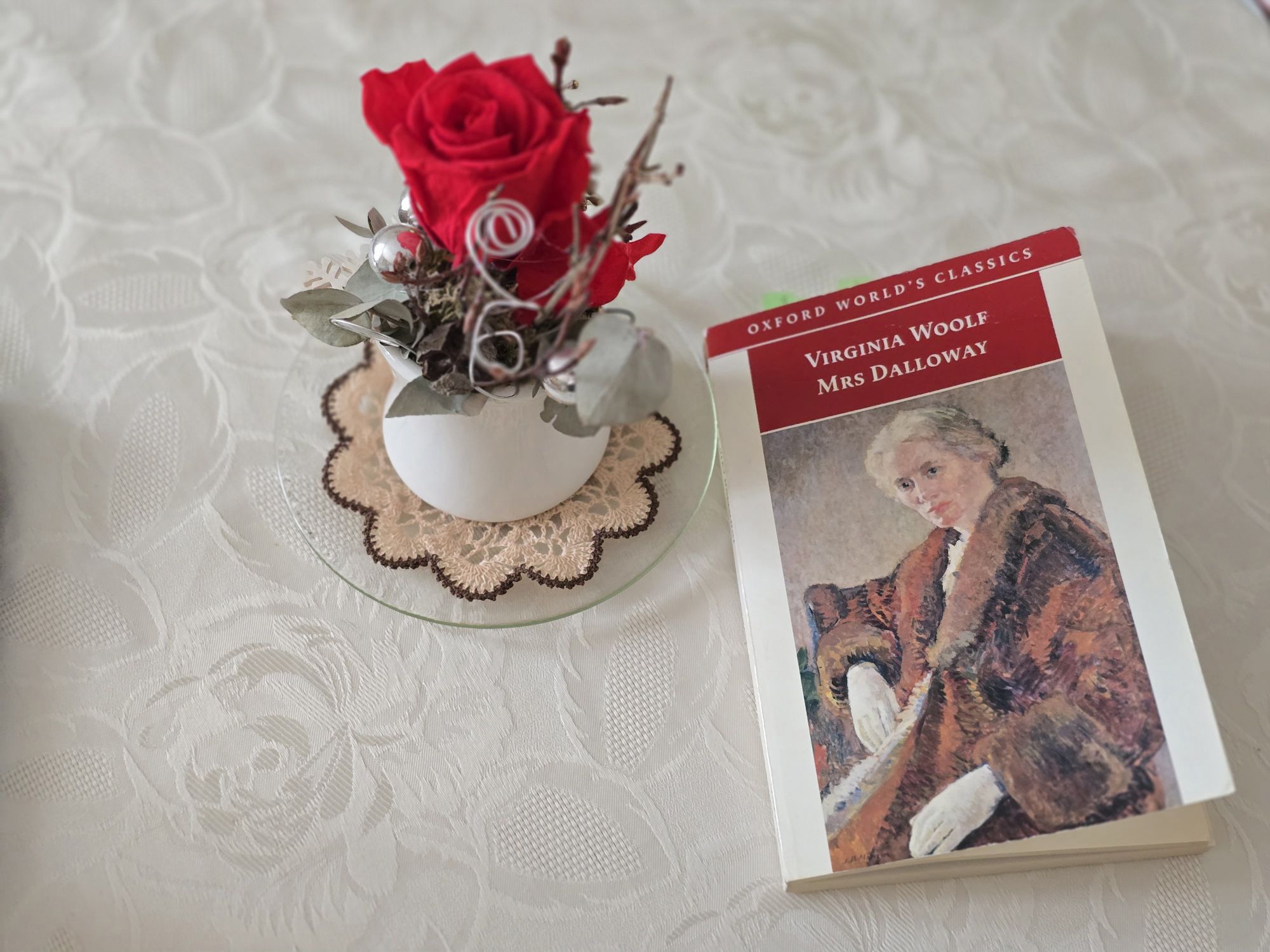London is the kind of city you understand best through its literature, and for me no other novel beats Virginia Woolf’s Mrs Dalloway at its London-ness. But my trip wasn’t straightforward. Growing up in Romania in the ‘90s, London was the dream city, but the sounds of London were muted, and the pictures of London were grey. Because speaking English was the ticket you needed to set foot in that dream destination. I still remember the first thing my English teacher told us in the first class: in English, you speak the words one way and write them a different way. Useful to keep that in mind 30 years later.
This state of mind can be extended to London: you think of London one way, and you experience it in a different way. I’ve had the chance to see London enough times to gather a bucketful of experiences, from West End shows and foods to its countryside outskirts. But thinking of London conjures a different image in mind – a city of light and shadow, of literature and violence, of poor and rich. And what better way to think about the city than to read its great books? In addition to Mrs Dalloway there’s Charles Dickens’s Great Expectations, Joseph Conrad’s The Secret Agent, Oscar Wilde’s The Picture of Dorian Gray and Elizabeth Bowen’s The Heat of the Day , all great London novels.
Looking back through my posts, I realize that I wrote about and mentioned Mrs Dalloway quite a couple of times, but I never really wrote an introductory post on the novel for newcomers to Virginia Woolf’s masterpiece. To provide some basics, Mrs Dalloway follows the main character, Clarissa Dalloway, as she spends a day walking through Central London, reminiscing on her past. The story culminates in the evening when Clarissa hosts a party for which she had famously bought the flowers herself. But besides Clarissa, there are many other characters, main and minor, who populate this version of 1923 London. There’s Peter Walsh, Clarissa’s one-time suitor visiting her in the morning; there’s Richard, Clarissa’s husband, returning home after a lunch party, and there’s Septimus Warren Smith and his wife Rezia, a couple struggling to get a grip on Septimus’s mental fragility in the wake of the Great War.
walking sounds of london in mrs dalloway
Framed by memories of her youth, Clarissa’s walk through London on a sunny June morning provides a window into her life. Her route, which can be traced quite precisely because of the hints in the book, reveals a deeply personal connection to the city. Clarissa’s journey from her home in Westminster to the flower shop on Bond Street is far from random. Woolf weaves memories and connections between characters and places into the narrative, lingering on how intimately everyone is linked to everyone else. Ant the best way to understand this is to walk into Clarissa’s footsteps yourself.
Each impression Clarissa receives, each sight and each street corner is pinned down by the exact location where Clarissa finds herself at any given moment. She starts at her house in Westminster, when she hears Big Ben striking “the hour, irrevocable” and crosses Victoria Street thinking, “such fools we are” for being in love with the life in the great city of London. Entering St James Park, Clarissa leaves behind the rumble of the street and notices “the silence; the mist; the hum; the slow-swimming happy ducks”, which draw her thoughts towards her past relationship with Peter Walsh and his current whereabouts.
Walking down Piccadilly, Clarissa looks in the window of Hatchard’s, one of London’s oldest book shops, and a Shakespeare volume catches her eye, pushing her thoughts towards the suffering “this late age of world’s experience” has caused people. She is, of course, thinking of the Great War and how a certain Lady Bexborough came to terms with her losses. The pavement of Bond Street catches Clarissa’s next steps, and she finds herself in the midst of the loud web of the sounds and memories of a past London.
Bond Street fascinated her; Bond Street early in the morning in the season; its flags flying, its shops; no splash; no glitter; one roll of tweed in the shop where her father had bought his suits for fifty years; a few pearls; salmons on an iceblock.
Books always leave more to uncover. Subscribe to get more reflections and interpretations delivered by email.
music of the battered woman
One of my absolute favourite moments in the novel is when Peter Walsh walks towards Regent’s Park Tube Station and hears the song of the battered woman. “A sound interrupted him; a frail, quivering sound, a voice bubbling up without direction, vigour, beginning or end”. Her song, an unusual sound and murmur, disrupts Peter’s thoughts and the rhythm of London’s usual sounds – the clatter of carriages, the chime of Big Ben.
But Woolf goes even further. It’s not only that the battered woman’s physical presence interrupts Peter’s walk and interrupts an outside London which barely spares a thought for her. Her spiritual presence tears through the city’s temporal facade and reveals a universal human sensibility. The large urban tapestry melts into the image of a green Earth and an ancient song, which tear themselves apart from the fleeting present.
big ben and st margaret
One feels even in the midst of traffic, or waking at night, Clarissa was positive, a particular hush, or solemnity; an indescribable pause; a suspense before Big Ben strikes. There! Out it boomed. First a warning, musical; then the hour, irrevocable.
Each character follows their own path and their own chaotic trains of thought. But there is one sound which acts as the beating heart of the book, probably one of the most widely recognizable sounds of London. The chimes of Big Ben. It’s almost as if each character is a Londoner because they hear Big Ben, which momentarily connects them to a common sliver of time.
For Clarissa, Big Ben’s chimes often evoke reflections on mortality and the fleeting nature of life. For Peter Walsh, the sound punctuates his inner turmoil and memories of the past. Septimus also hears the chimes, which resonate with a haunting clarity for him, often amplifying his sense of alienation.
But there is also “the other clock, the clock which always struck two minutes after Big Ben”. That’s St. Margaret, a church built next to Westminster Abbey as an alternative for the large crowds who would attend mass. Big Ben’s chimes are loud and authoritative, a sign of the relentless passing of time, while St Margaret’s, delayed, maybe a bit awkward and off-handed, bring a more conversational tone to the soundscape of London. Big Ben anchors the characters in the present modernity, while St Margaret suggests a connection to something timeless, dispersed and indescribable that exists in each of us. Together, they create London as a space where history and personal experience coexist and interact.
I have visited London with Mrs Dalloway in mind this year and will probably visit it again next year and the year after. There’s nothing quite like the shock of silence that welcomes me when I step down from the city’s high streets into Hyde Park or the sheer number of second-hand bookstores in Charing Cross. Then there’s of course all the art, history and shows which just take my breath away when in Central London. But that’s what it means for me to experience the city. Thinking of the city is, of course, a different matter altogether.
This post was inspired by the Literature Cambridge 2024 course on London in Literature. The ideas explored here are indebted to Dr Angela Harris’s insightful lecture on the interconnected lives of Londoners in Mrs Dalloway.







your thoughts?